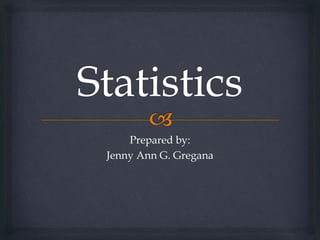
Statistics
- 1. Prepared by: Jenny Ann G. Gregana
- 2. What is Statistics? The purpose of statistics is to develop and apply methodology for extracting useful knowledge from both experiments and data. In addition to its fundamental role in data analysis, statistical reasoning is also extremely useful in data collection (design of experiments and surveys) and also in guiding proper scientific inference (Fisher, 1990).
- 3. What is Statistics? Statistics is neither really a science nor a branch of mathematics. It is perhaps best considered as a meta-science (or meta-language) for dealing with data collection, analysis, and interpretation. As such its scope is enormous and it provides much guiding insight in many branches of science, business.
- 4. Brief History of Statistics The Word statistics have been derived from Latin word “Status” or the Italian word “Statista”, meaning of these words is “Political State” or a Government. Shakespeare used a word Statist is his drama Hamlet (1602). In the past, the statistics was used by rulers. The application of statistics was very limited but rulers and kings needed information about lands, agriculture, commerce, population of their states to assess their military potential, their wealth, taxation and other aspects of government.
- 5. Brief History of Statistics Basic forms of statistics have been used since the beginning of civilization. Early empires often collated censuses of the population or recorded the trade in various commodities. The Roman Empire was one of the first states to extensively gather data on the size of the empire's population, geographical area and wealth.
- 6. Brief History of Statistics During the 20th century several statistician are active in developing new methods, theories and application of statistics. Now these days the availability of electronics computers is certainly a major factor in the modern development of statistics.
- 7. History of Statistics Time Contributor Contribution Ancient Greece Philosophers Ideas - no quantitative analyses 17th Century Graunt, Petty Pascal, Bernoulli studied affairs of state, vital statistics of populations studied probability through games of chance, gambling 18th Century Laplace, Gauss normal curve, regression through study of astronomy Timeline
- 8. History of Statistics Timeline 19th Century Quetelet Galton astronomer who first applied statistical analyses to human biology studied genetic variation in humans(used regression and correlation)
- 9. History of Statistics 20th Century (early) Pearson Gossett (Student) Fisher studied natural selection using correlation, formed first academic department of statistics, Biometrika journal, helped develop the Chi Square analysis studied process of brewing, alerted the statistics community about problems with small sample sizes, developed Student's test evolutionary biologists - developed ANOVA, stressed the importance of experimental design Timeline
- 10. 20th Century (later) Wilcoxon Kruskal, Wallis Spearman Kendall Tukey Dunnett Keuls Computer Technology biochemist studied pesticides, non-parametric equivalent of two-samples test economists who developed the non-parametric equivalent of the ANOVA psychologist who developed a non-parametric equivalent of the correlation coefficient statistician who developed another non-parametric equivalent the correlation coefficient statistician who developed multiple comparisons procedure biochemist who studied pesticides, developed multiple comparisons procedure for control groups agronomist who developed multiple comparisons procedure provided many advantages over calculations by hand or by calculator, stimulated the growth of investigation into new techniques
- 11. Statisticians Sir William Petty -a 17th-century economist who used early statistical methods to analyze demographic data.
- 12. Statisticians Carl Friedrich Gauss, -mathematician who developed the method of least squares in 1809.
- 13. Statisticians Karl Pearson, the founder of mathematical statistics.
- 14. Statisticians Ronald Fisher "A genius who almost single-handedly created the foundations for modern statistical science",
- 15. Statisticians James Lind -carried out the first ever clinical trial in 1747, in an effort to find a treatment for scurvy.
- 16. Statisticians Pierre-Simon -marquis de Laplace, one of the main early developers of Bayesian statistics.
- 17. Merci Beaucoup
